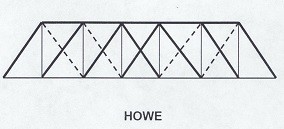Wooden Trusses in Tennessee
While many people think of covered bridges as synonymous with wooden truss bridges, they are not. Any type of bridge can have a barn-like covering - a slab, girder, beam or truss bridge. However, in the 19th and early 20th centuries, virtually all covered bridges were wooden truss bridges.
Even so, not all wooden truss bridges were covered. Railroads built several non-covered wooden truss bridges in Tennessee. The railroads built them to carry vehicular traffic on local roads over railroad tracks, providing grade-separated crossings. On the surface, it may seem inconsistent that the railroads, which were generally technologically innovative in bridge design, would use a comparatively primitive design for these bridges. Such a design probably appeared to be the most economical and efficient for bridges carrying vehicular traffic, compared to rail lines that carried heavier rail traffic. Virtually all of Tennessee's railroad-built wooden truss bridges that survived into the 1980's utilized either the Queenpost or Kingpost design and had construction dates ranging from the 1910's into the 1940's. With regular applications of creosote, these bridges have withstood traffic and weather.

Although no uncovered vehicular wooden truss bridges built by someone other than the railroads are known to remain in Tennessee, the counties built many such bridges. Perhaps the last such bridge to survive was a short Howe truss in eastern Montgomery County across Big McAdoo Creek. The county abandoned this bridge when it built a new bridge nearby around 1960. The wooden bridge collapsed in the 1980s. Also, between 1926 and 1932, the newly-formed Tennessee State Highway Department developed standardized plans for wooden truss bridges that included Howe, Queenpost, and Kingpost designs. However, it is unknown if the state ever erected any bridges from these plans.